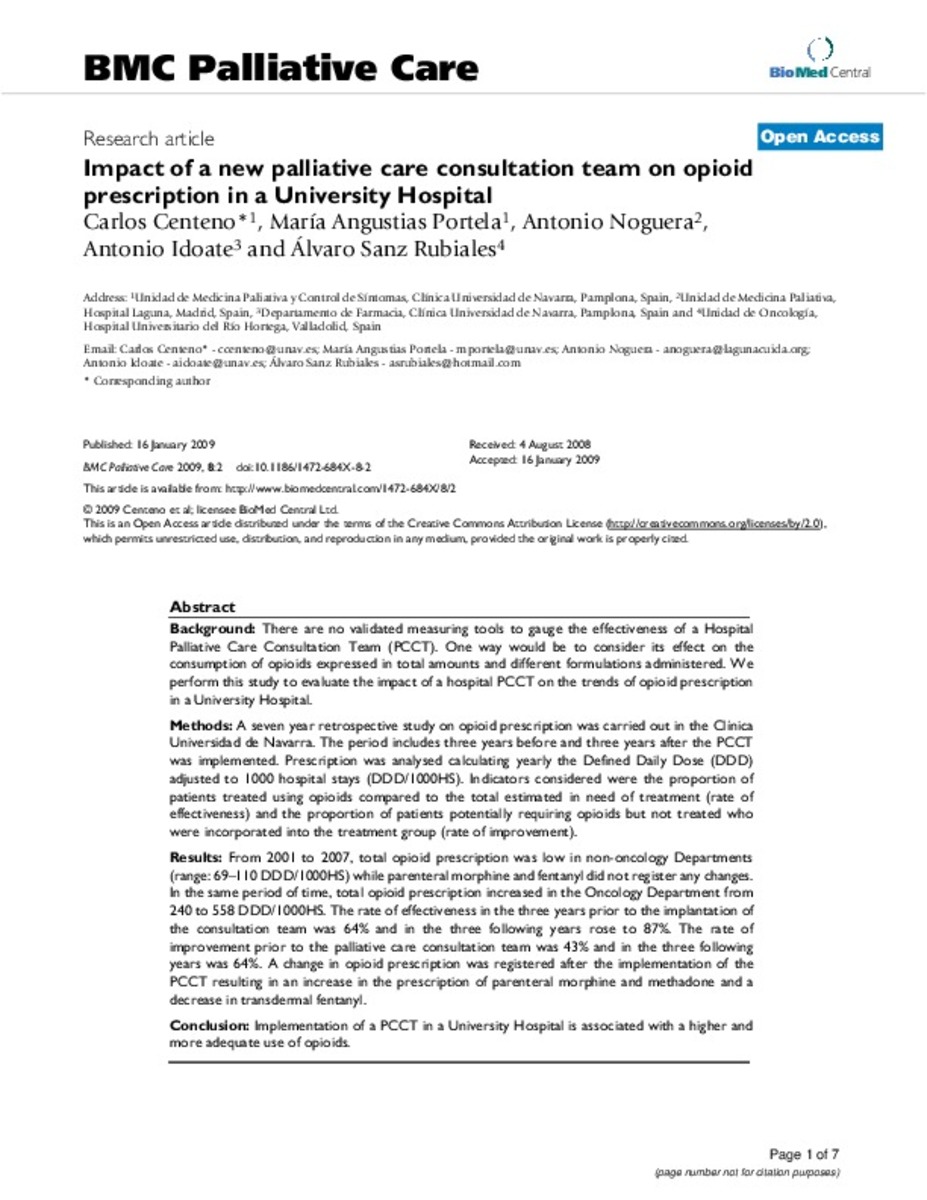Registro completo de metadatos
| Campo DC | Valor | Lengua/Idioma |
|---|---|---|
| dc.creator | Centeno, C. (Carlos) | - |
| dc.creator | Portela, M.A. (María Angustias) | - |
| dc.creator | Noguera, A. (Antonio) | - |
| dc.creator | Idoate, A. (Antonio) | - |
| dc.creator | Sanz-Rubiales, A. (Álvaro) | - |
| dc.date.accessioned | 2012-06-18T15:50:54Z | - |
| dc.date.available | 2012-06-18T15:50:54Z | - |
| dc.date.issued | 2009 | - |
| dc.identifier.citation | Centeno C, Portela MA, Noguera A, Idoate A, Rubiales AS. Impact of a new palliative care consultation team on opioid prescription in a University Hospital. BMC Palliat Care 2009 Jan 16;8:2. | es_ES |
| dc.identifier.issn | 1472-684X, | - |
| dc.identifier.uri | https://hdl.handle.net/10171/22603 | - |
| dc.description.abstract | There are no validated measuring tools to gauge the effectiveness of a Hospital Palliative Care Consultation Team (PCCT). One way would be to consider its effect on the consumption of opioids expressed in total amounts and different formulations administered. We perform this study to evaluate the impact of a hospital PCCT on the trends of opioid prescription in a University Hospital. Methods: A seven year retrospective study on opioid prescription was carried out in the Clínica Universidad de Navarra. The period includes three years before and three years after the PCCT was implemented. Prescription was analysed calculating yearly the Defined Daily Dose (DDD) adjusted to 1000 hospital stays (DDD/1000HS). Indicators considered were the proportion of patients treated using opioids compared to the total estimated in need of treatment (rate of effectiveness) and the proportion of patients potentially requiring opioids but not treated who were incorporated into the treatment group (rate of improvement). Results: From 2001 to 2007, total opioid prescription was low in non-oncology Departments (range: 69–110 DDD/1000HS) while parenteral morphine and fentanyl did not register any changes. In the same period of time, total opioid prescription increased in the Oncology Department from 240 to 558 DDD/1000HS. The rate of effectiveness in the three years prior to the implantation of the consultation team was 64% and in the three following years rose to 87%. The rate of improvement prior to the palliative care consultation team was 43% and in the three following years was 64%. A change in opioid prescription was registered after the implementation of the PCCT resulting in an increase in the prescription of parenteral morphine and methadone and a decrease in transdermal fentanyl. Conclusion: Implementation of a PCCT in a University Hospital is associated with a higher and more adequate use of opioids. | es_ES |
| dc.language.iso | eng | es_ES |
| dc.publisher | BioMed Central | es_ES |
| dc.rights | info:eu-repo/semantics/openAccess | es_ES |
| dc.subject | Palliative care | es_ES |
| dc.subject | Opioid prescription | es_ES |
| dc.title | Impact of a new palliative care consultation team on opioid prescription in a University Hospital | es_ES |
| dc.type | info:eu-repo/semantics/article | es_ES |
| dc.relation.publisherversion | http://www.biomedcentral.com/content/pdf/1472-684X-8-2.pdf | es_ES |
| dc.type.driver | info:eu-repo/semantics/article | es_ES |
Ficheros en este ítem:
Estadísticas e impacto
Los ítems de Dadun están protegidos por copyright, con todos los derechos reservados, a menos que se indique lo contrario.






